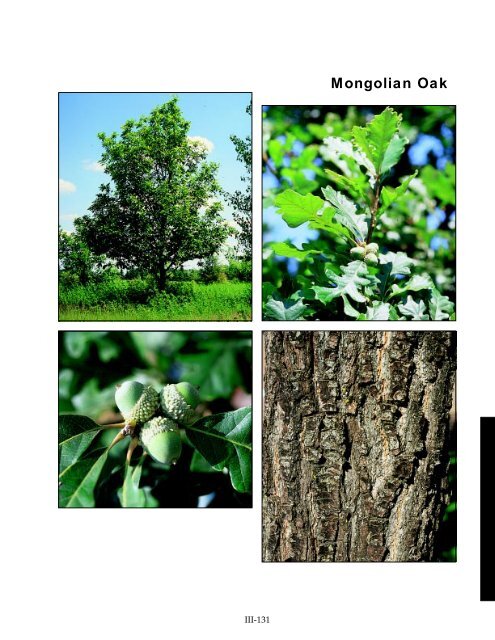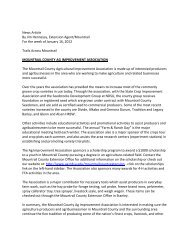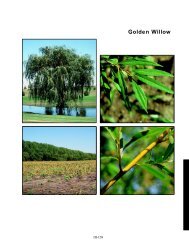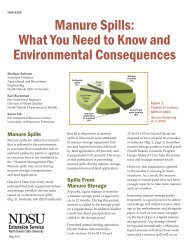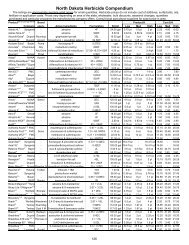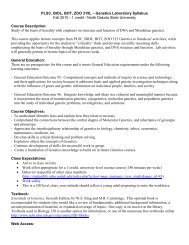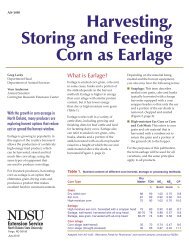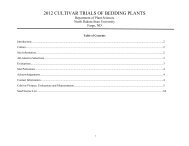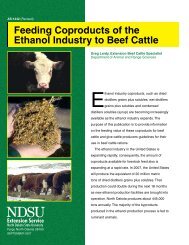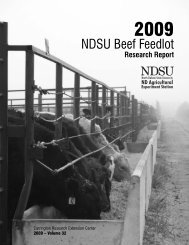Create successful ePaper yourself
Turn your PDF publications into a flip-book with our unique Google optimized e-Paper software.
<strong>Mongolian</strong> <strong>Oak</strong><br />
slide 65c<br />
360%<br />
III-131
<strong>Mongolian</strong> <strong>Oak</strong><br />
(<strong>Quercus</strong> <strong>mongolica</strong>)<br />
General Description<br />
A medium to large tree forming an open, somewhat<br />
irregular crown at maturity. Native to eastern Asia.<br />
Growth and performance in <strong>NDSU</strong> trials are similar to Bur<br />
<strong>Oak</strong>. Rosy-red fall leaf color often occurs and leaves are<br />
retained into early or mid-winter. The largest tree<br />
in North Dakota is 26 feet tall with a canopy spread<br />
of 28 feet.<br />
Leaves and Buds<br />
Bud Arrangement - Alternate.<br />
Bud Color - Pale pubescence covering entire bud.<br />
Bud Size - Imbricate, conical to broadly ovate, 1/8 to<br />
1/4 inch.<br />
Leaf Type and Shape - Simple, leaves are obovate-oblong,<br />
auricled base.<br />
Leaf Margins - Leaves are not truly lobed but have a wavy<br />
margin with large blunt teeth, termed sinuate-dentate.<br />
Leaf Surface - Glabrous except for a few tufts of hair on the<br />
main veins below.<br />
Leaf Length - 4 to 8 inches.<br />
Leaf Width - 2 to 3 inches.<br />
Leaf Color - Dark green above, paler below; in autumn<br />
leaves develop rose shades below, bronzy-brown above<br />
and often partially retained into winter.<br />
Flowers and Fruits<br />
Flower Type - Catkins.<br />
Flower Color - Male is yellow-green; female is reddish.<br />
Fruit Type - Acorn about 3/4 inch long in a fringed cup.<br />
Fruit Color - Brown.<br />
Form<br />
Growth Habit - Open crown, spreading.<br />
Texture - Medium-coarse, summer; coarse, winter.<br />
Crown Height - 30 to 50 feet.<br />
Crown Width - 30 to 40 feet.<br />
Bark Color - Dark gray, with rough, deep ridges and<br />
furrows.<br />
Root System - Deep taproot, spread is usually twice tree<br />
height.<br />
Sensitive to construction and transplanting injury.<br />
Environmental Requirements<br />
Soils<br />
Soil Texture - Grows best in fertile loam, but will do well<br />
in a wide variety of soils.<br />
Soil pH - 5.5 to 7.5.<br />
Windbreak Suitability Group - 1, 3, 4, 4C, 5.<br />
Cold Hardiness<br />
USDA Zone 3.<br />
Water<br />
Drought tolerant, but prefers moist well-drained soils.<br />
Light<br />
Full sun preferred, but is shade tolerant.<br />
Uses<br />
Conservation/Windbreaks<br />
Medium to tall tree for farmstead and field windbreaks.<br />
Wildlife<br />
Excellent tree for wildlife food and cover.<br />
Agroforestry Products<br />
Wood - Most oaks are used in furniture and finishing<br />
lumber.<br />
Medicinal - Extracts of some oak species have been used as<br />
an astringent and antiseptic. Used for dysentery by native<br />
Americans and early settlers.<br />
Urban/Recreational<br />
Excellent for boulevard, landscaping, yards, and parks.<br />
Sensitive to root compaction. Grows at same rate as bur<br />
oak. Merits greater use.<br />
None.<br />
Cultivated Varieties<br />
Related Species<br />
Bur <strong>Oak</strong> (<strong>Quercus</strong> macrocarpa)<br />
English <strong>Oak</strong> (<strong>Quercus</strong> robur) - Lacks sufficient hardiness in<br />
North Dakota, but <strong>NDSU</strong> has hardy hybrid selections<br />
under consideration for introduction.<br />
Pests<br />
No major pest problems known other than a twig proliferation<br />
insect complex.<br />
III-132


